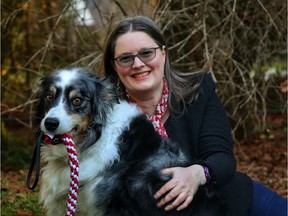Reviews and recommendations are unbiased and products are independently selected. Postmedia may earn an affiliate commission from purchases made through links on this page.

Got an anxious, fearful and reactive dog? B.C. author shares her tips
Vancouver author Zazie Todd’s book Bark! uses canine science to help you better understand your dog’s behaviour

Article content

Is your dog doing biting, aggressively barking or hiding under the furniture?
Those behaviours are signs of anxiety and reactivity, and Vancouver author Zazie Todd, the author of the books Wag and Purr and the award-winning blog Companion Animal Psychology, wants to help calm your precious pet.
In her new book Bark! Todd looks closely at canine science and offers advice and action plans to help you understand and address the fears your dog may be experiencing. We caught up with Todd and asked her a about understanding our beloved pals better.
Advertisement 2
Article content
Q: What is this book designed to do?
A: The book is designed to help anyone who has a fearful, anxious, reactive or shy dog to understand their dog better and have strategies to help them. The first section of the book looks at how fears and anxieties develop, when to see a veterinarian in case there is a medical component, and how to use kind, humane training techniques with a fearful dog. The second part is designed to help with different kinds of fears, from resource guarding and reactivity to separation-related issues, while the third part draws it all together. It’s very up-to-date and it’s written to be easy to understand. And having a fearful dog can sometimes be very hard for the human, so there are tips to help the humans to cope, too.
Q: How prevalent is anxiety in our dogs?
A: Unfortunately fears and anxieties are very common in our dogs, with one study finding that 72.5 per cent of dogs have some kind of anxiety. Being afraid of loud noises such as fireworks is very common, but other common fears include being afraid of unknown dogs (often called reactivity) or of unknown people. People can feel very alone when they have a fearful dog because we have these stereotypes about the dog-human relationship being so good for us, so it feels hard if you’re struggling. But you’re not alone; there are a lot of people dealing with these issues, and there’s a lot that can be done to help.
Article content
Advertisement 3
Article content
Q: Is anxiety genetic or does it develop over time?
A: A combination of factors contribute to fears and anxieties. To some extent it is genetic, which is why it’s always best to see both parents, if possible, when getting a puppy so you can check that they have a friendly temperament. Inadequate socialization during the sensitive period for puppies (between three and 12 to 14 weeks) can contribute, and this may especially be an issue for pandemic puppies because people could not easily socialize them at that time. And anxiety can also develop over time, for example if the dog has bad experiences. But if it develops suddenly in an adult dog, see your veterinarian in case pain or another medical issue is contributing.

Q: What are some of the key signs a dog is suffering from anxiety?
A: The dog’s body language is the first clue — a lowered posture, a tucked tail, looking away, licking the lips (when not expecting food), and hiding are some of the signs. The better you get at reading canine body language, the easier it will be for you to help your dog because then you can step in when you notice they are afraid.
Advertisement 4
Article content
Q: What is the biggest mistake people make when dealing with an anxious dog?
A: The biggest mistake is probably to do nothing, hoping that it will go away. It’s more likely that because the dog keeps being exposed to the thing they are afraid of, they will get more and more fearful over time. It’s important to help your dog to feel safe (and it’s feeling safe, not just being safe, that counts). A good dog trainer can really make a difference. Nut because dog training isn’t regulated, it’s essential to choose someone who will only use humane methods. In B.C., look for a trainer who is AnimalKind certified.
Q: What can we change about our own behaviour to help make things better for our anxious dog?
A: We can give dogs more choices and more control over their own lives, and try to give them more positive experiences (from their point of view). For example, a lot of people like to hug dogs — even dogs they don’t know — but many dogs don’t like it and they don’t have the choice to move away. Always check that the dog is happy to be petted, which you can do by pausing and waiting to see if they lean in for more or move away. We call this a consent test. And make sure the dog has a safe space in your home, like a dog bed or a crate, where they can go whenever they like and where you will never disturb them.
Advertisement 5
Article content
Q: Is this book also helpful for dog owners who don’t have an anxious dog? And why?
A: Yes, it’s helpful for any dog guardian because it includes lots of tips on how to train dogs, how to give them a safe space, how to get medication into your dog, and so on. There’s also a section on how to become a dog trainer or find a career working with dogs because some people learn so much to help their fearful dog that they want a change of career. And any dog lover will enjoy the stories of my own pets that are included in the book.
Dgee@postmedia.com
twitter.com/dana_gee
Recommended from Editorial
Article content






